Editors' Choice 2012: The Best Backpacking Gear of the Year
From a smart-and-light pack to a groundbreaking backcountry communicator, here are the 12 products that passed the ultimate gear challenge.
MSR WhisperLite Universal
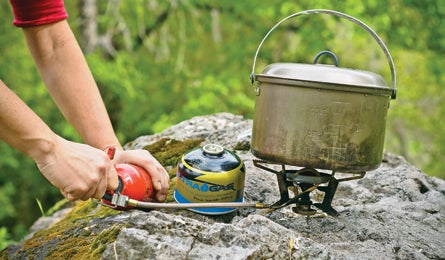
Finally. For years, we’ve been hunting for a multifuel stove that burns both liquid gas and canister fuel, burns them equally well, and easily converts from one mode to another. The Universal is that stove—and possibly the last one you’ll need to buy. We cooked it side-by-side with a half-dozen current and past multifuel stoves, and testers from BACKPACKER and CLIMBING reached this verdict: It burns as hot and efficiently in liquid-fuel mode as any; it performs better in subfreezing and high-altitude conditions; and its field-fixable and -cleanable construction gives it an advantage in a category notable for the importance of durability (a failed stove would have ended our trip in Chile, as we had to melt snow for drinking water).
Even better, it solves the two challenges historically plaguing multifuel stoves: lackluster performance in canister mode, and clunky conversion processes with too many steps or pieces. In controlled conditions, it beat every other multifuel stove in boil-time tests with canisters, and compared favorably with (and even beat some) dedicated canister stoves, especially in cold temps. That’s unprecedented, and it’s due to engineering that inverts the canister and burns the fuel evenly. The technology, called AirControl, adjusts the oxygen/fuel mix to prevent the steep tail-off commonly seen as fuel pressure drops. And switching modes only requires two steps: swapping jets on the head of the fuel line, and attaching the new nozzle to the fuel pump (liquid gas) or canister.
Testers had two gripes—priming can be futzy, and you must take care not to lose several small parts—but overall they agreed with an editor who called it “the new benchmark for stove versatility.” $140; 11.5 oz. (liquid-fuel mode); 9.5 oz. (canister-fuel mode); cascadedesigns.com
Sawyer Squeeze Water Filter
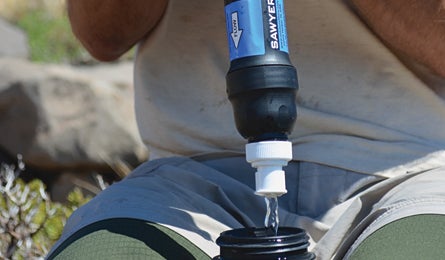
Here’s proof that outside-of-the-box thinking doesn’t have to be complicated. This ingenious water-treatment device works like a simple toothpaste tube to squeeze water through a hollow-fiber membrane. Result: You get the effectiveness of a filter without the hassle of a pump. “It’s light, compact, fast, and ridiculously easy to use,” rejoices one tester. The soda-bottle-size opening on the Mylar bag (kit comes with 16-, 32-, and 64-ounce capacities) makes it easy to fill from all but the weakest trickles.
Then screw on the cylindrical filter element, which removes bacteria and protozoa, and squeeze or roll the bag to shoot a stream of water into your bottle (or mouth). Bonus: The bag system lets you filter anywhere, not just huddled over a stream as pumps typically require. It’s actually faster than most pumps, and has no complicated mechanism that can break. From California’s Lost Coast to the Andes, we had zero field failures. Packed, the setup is as small as a Red Bull can. And longevity? It’s cleanable, and Sawyer offers a million-gallon guarantee. $50; 4 oz. (with 32-oz. bag); sawyer.com
Salomon Synapse Mid
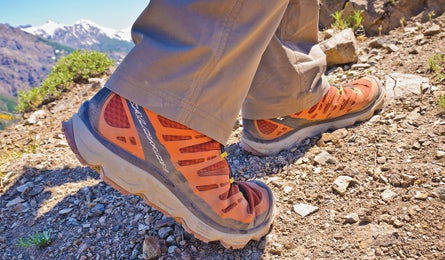
After climbing 5,100 feet from the rock-strewn bottom of the Rio Melado valley to the snowy heights of Chile’s central Andes, one tester hailed the Synapse Mids as “the perfect blend of cushion and security in an incredibly light package.” The performance comes from the integration of several key design features. For starters, the springy EVA midsole extends out from the heel, providing a platform nearly a half-inch wider than your footprint.
That, combined with a snug synthetic upper and one-pull lacing that lock your foot in place, provides superior stability for the weight. And you still get smooth, easy striding that feels trail-runner fast. Credit a rounded heel that softens each foot strike, and the higher-than-average drop from heel to toe (14mm), which our tester says “felt like it quickened my stride.”
The large, staggered lugs flex on impact, while bands of plastic running from heel to toe snap the shoe back after toe-off, creating a rebound effect. Add a pronounced rocker—or curved sole—and the whole package combines to offer an “agile, full-speed-ahead feel.” Tightly woven mesh across much of the upper delivers hot-weather breathability, yet it still repelled grit and debris on dusty trails and bushwhacks. The absence of stiff midsole protection makes it best with moderate loads. Don’t need the ankle support? The Synapse comes in a low-cut version ($120) that ultrahiker Jennifer Pharr Davis used to set a new Appalachian Trail speed record last year. $140; 1 lb. 10 oz. (men’s 9); m’s 7-13, w’s 5-10; salomon.com
Snow Peak SnowMiner
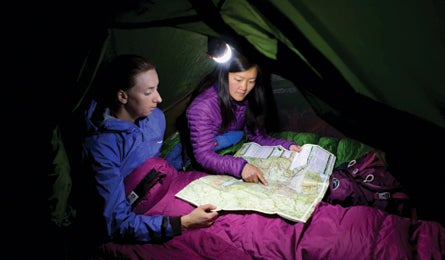
Who says there’s no such thing as a free lunch? This headlamp performs just fine on trail, and it becomes a lantern in camp—at virtually no extra weight or cost. The key is an ingenious design that uses a tiny magnet to let you instantly switch between headlamp and lantern. Squeeze the silicone globe to pop it out into lantern mode; push the center back in against the lens to return to headlamp.
On trail, it shoots a tiltable, 80-lumen beam bright enough for night hiking (about 100 feet on high). Retiring to the tent for cards? Convert the SnowMiner to lantern, then hang it from the included strap hook. The globe disperses a pool of ambient light that’s big enough to reach the far corners of a four-person tent and lacks the dark spots we’ve seen in some mini lanterns. “The light is warm and even, and you can fade it all the way to two lumens, which creates a candlelit feel,” says one tester. Three AAAs last 45 hours on high. $50; 3.5 oz.; snowpeak.com
Feathered Friends Spoonbill
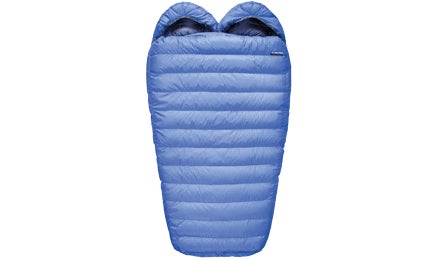
Who says ultralight can’t be sexy? This double bag weighs little more than many single sacks in its temp category, but lets you and your sweetie share, er, warmth. “I’ve zipped bags together and tried heavier doubles,” says one tester. “This is a revelation.” The 900-fill love nest is much more than an extra-wide bag. The key innovation: Independently adjustable hoods, draft collars, and footboxes that maximize insulation in subfreezing temps.
Feathered Friends says the complex design took eight years to develop. Premium down, wispy Pertex UL fabric, and the absence of bottom insulation further reduce weight. The Spoonbill has no official rating, but our consensus: Five inches of loft and shared warmth make this a legit winter (above zero) bag. Our testers had to open the individual, two-way zippers because they found the bag too warm on a 25°F night in Arizona. Bonus: The Spoonbill fit our 6’6” tester. $800; 2 lbs. 9 oz. (reg.); two lengths; also available with 850-fill and Schoeller Nanospshere shell for $100 less; featheredfriends.com
inReach by DeLorme
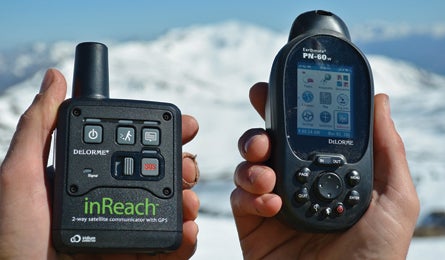
Talk about a game changer. Not only can this palm-size device send text messages, post to Facebook and Twitter, signal rescuers, and track real-time progress on an online map, but when paired with DeLorme’s Earthmate PN-60w ($350, a 2011 Editors’ Choice Award winner) or an Android phone, the inReach also lets you receive messages. “During treks in the Tetons and Andes, the two-way texting enabled me to maintain a running dialogue with friends and family,” says our editor-in-chief.
And testers weren’t the only ones who welcomed the interaction. “My kids’ classes followed my progress in Chile and fired me questions,” says our gear editor. That’s the fun side. In an emergency, the SOS feature allows you to text info back and forth with responders. (When used as a standalone rescue device, the light above the SOS button blinks faster to show that help is coming.)
Setup is hassle-free. Create an account at explore.delorme.com, enter a list of contacts, and write three predefined messages that can be sent via the inReach alone. Sync it with the GPS or DeLorme’s Android app, both of which allow you to write many more preset messages. Testers said that the intuitive interfaces make the system a snap to use in the field: Select the inReach icon from the menu screen to enable tracking, type or read messages (you’ll receive confirmation when your message is sent), post social media updates, or initiate the SOS.
When operating the inReach by itself (you’re limited to sending predetermined messages, but friends at home can still follow your progress on a map) testers could power the unit roughly five days on a pair of lithium AAs.
Caveat: Sharing your adventures in real-time can lead to substantial jealousy. Our editors were pinged with messages ranging from “Wish I was there!” to “As I sit here staring at spreadsheets, I must say that I hate your guts.” $250, plus a $12 activation fee (Earthmate PN-60w sold separately); monthly data rates range from $10-$50 (SOS messages don’t count toward your monthly allotment); 8.2 oz. (inReach only); delorme.com
L.L. Bean Microlight FS 2
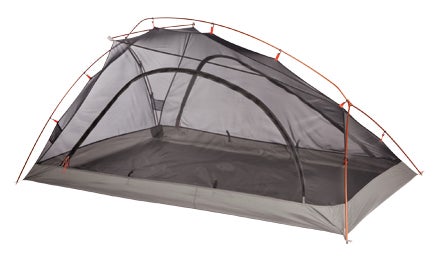
Initially, testers who received the Microlight feared for their comfort—and safety. “No way a tent this cheap and light can offer adequate space and real weather protection,” declared one tester, who then went out and promptly proved himself wrong by pitching the Microlight in Idaho’s Frank Church Wilderness, where it easily withstood 25-mph winds. That performance elevated the tent to a rarefied class: less than four pounds and less than $200, but with two doors, legit floor space, freestanding convenience, and three-season weatherproofing.
“Thanks to curved pole segments that maintain even tension on the fabric, the fly and tent body pitch without a ripple, so it doesn’t sag or flap noisily during gusts and heavy rain,” reports one tester. Setup is quick, with two Y-shaped hubbed poles and a brow segment that raises the crown. Two vestibules (each big enough to shelter two huge black Labs) deliver exceptional storage space for the weight. All-mesh walls virtually eliminated condensation, even on nights in the 30s in Idaho’s Sawtooth Wilderness. For additional ventilation in rainy weather, testers unzipped vestibules halfway (the design prevents rain from dripping in through the door). The 31-square-foot floor is long enough for six-footers, and the 39-inch peak height, while not the tallest in this category, let two testers sit up for a game of cards. Nitpick: You get just two small internal pockets. $199; 3 lbs. 15 oz.; llbean.com
Hungry Hikers Murray’s Hurried Curry
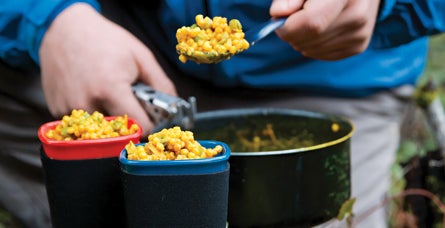
Around day four of any backpacking trip, the thought of another freeze-dried pasta dish sounds as appealing as a few fresh blisters. Which is why—after a 10-mile hike along a dusty dirt road in Chile that followed a 5,000-plus-foot descent at the end of our volcano trek—we were thrilled to have saved this curry dish for the end. The smell of coconut milk and curry alone was enough to give us a lift. Then the texture of the al dente Israeli couscous woke up tired taste buds.
And the combination of chicken (not tough and chewy) and peas (not mushy) in the coconut-curry sauce caused camp chaos: Was there enough to go around? And could we make another batch fast? Thankfully, the Hurried Curry lives up to its name: Just boil two cups of water, simmer the bag’s contents for 8 to 10 minutes, and devour. $9 (10 oz.; makes two 1-pound servings); hungryhikers.com
Kühl Liberator
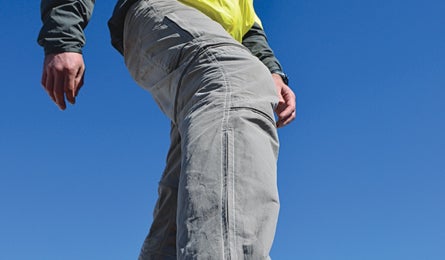
When you pack gear that does double duty, you save weight and hike farther. Duh. But when multitasking efficiency has been applied to the pants-cum-shorts category, we’ve found the benefit offset by the dork factor. Until now. The Liberator has a trim, mountain-town style that slyly masks the two-in-one design. Mobility-enhancing spandex strips mimic the zipper lines, so they stand out less, and small slots swallow the zipper pulls. And for hikers who say the backcountry is no place to worry about looks—that function always trumps form—don’t worry: The Liberator also packs a best-in-class array of clever technical features. The fabric is 77 percent nylon and 23 percent cotton—the nylon is next to skin, and the cotton is on the outer surface, lending a softer feel and greater durability.
“If there’s a lag in dry time, I can’t tell,” says one tester after wetting the lower legs during an early-winter creek crossing. “And there are no signs of wear, snags, or pilling after four months of regular use.” A gusseted crotch and thin, horizontal bands of spandex above the back pockets and below the articulated knees ensure flexibility for high stepping and crouching (female testers who tried the women’s version still wished for more flex). Spandex backing on every pocket securely cradles items stowed there, decreasing flop and sway. Transitioning from pants to shorts and back takes a minute or less, thanks to a foot-long, snap-closed cuff zipper that fits over all but the biggest winter or alpine boots our testers wore. Summed up one editor: “For three-season backpacking, this is my new go-to pair of pants. And shorts.” $89; 14 oz. (men’s 32); m’s 30-40; kuhl.com
Boreas Buttermilks 55 & Lost Coast 60
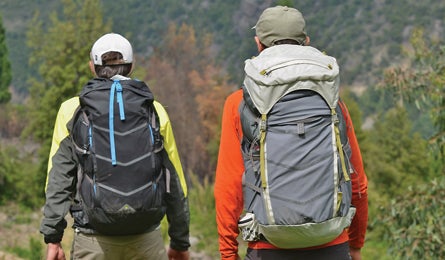
“We believe the best gear is neither complicated nor expensive.” That’s not the kind of statement one expects to hear from companies on the forefront of innovation, but that’s the philosophy that guides product development at Boreas, the company’s designers say. And judging by the Buttermilks (left) and Lost Coast (right), they’re serious. They created a near-perfect suspension system and a smart packbag—and refrained from adding any unnecessary extras that increase weight or cost. “It’s one of the most breathable backpanels I’ve ever used,” says one tester after summer hikes in Rocky Mountain National Park. “I can feel cool wind across my back and never soaked my shirt, all without any loss in pack volume.” The secret? Tough nylon mesh covers a variably corrugated foam backpanel that compresses as you hike to help move air.
Grooves are deeper across the upper back to enhance airflow and shallower across the lumbar area to improve load transfer (inspiration: the zigzagged midsole of Reebok’s Zig line of running shoes). Load transfer is similarly top-class, thanks to webbing-reinforced seams that wrap the packbag like a rib cage; they’re angled to pull the load in, countering the sag that plagues many packs. Lightweight, silicon-impregnated ripstop nylon reinforces the main packbag of each model, while heavier 420-denier nylon protects the bottoms. The foam-and-mesh hipbelt distributes weight evenly, and two massive hipbelt pockets swallow a camera, GPS, or snacks. Following the clean design ethos, daisy chains and ice axe loops on both packs tuck away, literally out of sight. For utmost convenience, go with the Lost Coast, which has a detachable, three-pocket top lid. Or save six ounces with the Buttermilks; it has no lid, just a cinch collar. “Either one can handle 45 pounds,” says a tester who packed a week’s supplies in Chile. Lost Coast 60: $200; 3 lbs. 3 oz.; Buttermilks 55: $175; 2 lbs. 13 oz.; boreasgear.com
Editors’ Choice Gold Awards
Kahtoola MICROspikes
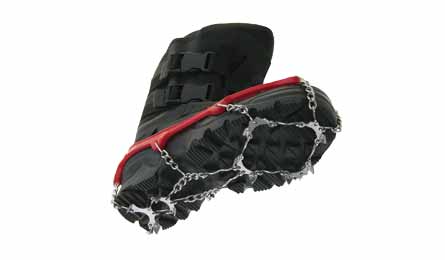
Moderate alpine routes often cause a safety vs. weight dilemma: Carry conventional crampons (heavy!) for low-angle snow and ice, or go without and risk a dangerous fall. Happily, MICROspikes offer a middle way, offering lightweight traction for use with any type of shoe. Since they came out in 2007, our staffers have used the low-profile spikes from the Rockies to the Alps. The steel teeth—almost a half-inch long—“bite into snow and icy trails like a mini crampon,” says one editor who used them to climb Chile’s Volcano San Pedro. “And the secure attachment doesn’t slip or shift.”
They couldn’t be easier to put on: Simply stretch the well-marked, elastic red band over any hiking boot or lowcut shoe and go (the XL fits over one editor’s size 13 mountaineering boots). Just make sure your partner packs a pair. A pregnant tester wearing the MICROspikes felt plenty secure on a Christmas day hike along the icy Lion Gulch Trail in Colorado, but she was bummed when her husband opted for a shorter route because his rubber-soled boots weren’t cutting it. Bonus: The 2012 model is updated with an easy-on heel tab, reinforced eyelets, and an even more durable band. $60; 14.4 oz. (L); XS-XL; kahtoola.com
Lodge Cast Iron Camp Dutch Ovens
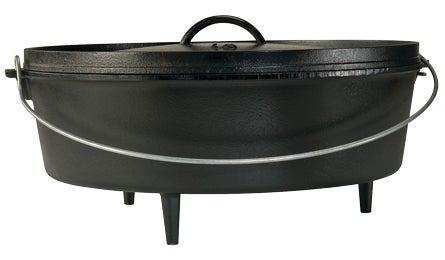
For more than two centuries, campers have been fueling adventures with meals made in these pioneer pots. Our editors have only been using them for a decade or so, but we’re convinced: For car-, horse-, and boat-camping trips, when weight is no object, nothing beats these ovens for fireside meals. Our enthusiastic test crew has used them to make mashed-potato-topped shepherd’s pie, hearty green chili with chicken, blueberry cobbler, and more. The technique is simple: Build a hot bed of coals (you can use charcoal briquettes, too), set the cauldron on top, and cover the flat lid with more coals.
Sit back and enjoy a beverage while you rotate the pot every 10 minutes or so (to ensure even cooking). Lodge offers a slew of sizes (from 1- to 12-quart); just be sure to get one of the “Camp” models that come with legs for elevating the pot over the coals. Each includes a booklet filled with recipes and maintenance tips; never wash your oven with soap, and oil it before storing to prevent rusting. “It’s a family heirloom,” says one tester. “I’ll be handing this down to my kids someday.” $44-$175; 18 lbs. 10 oz. (12 qt.); lodgemfg.com
